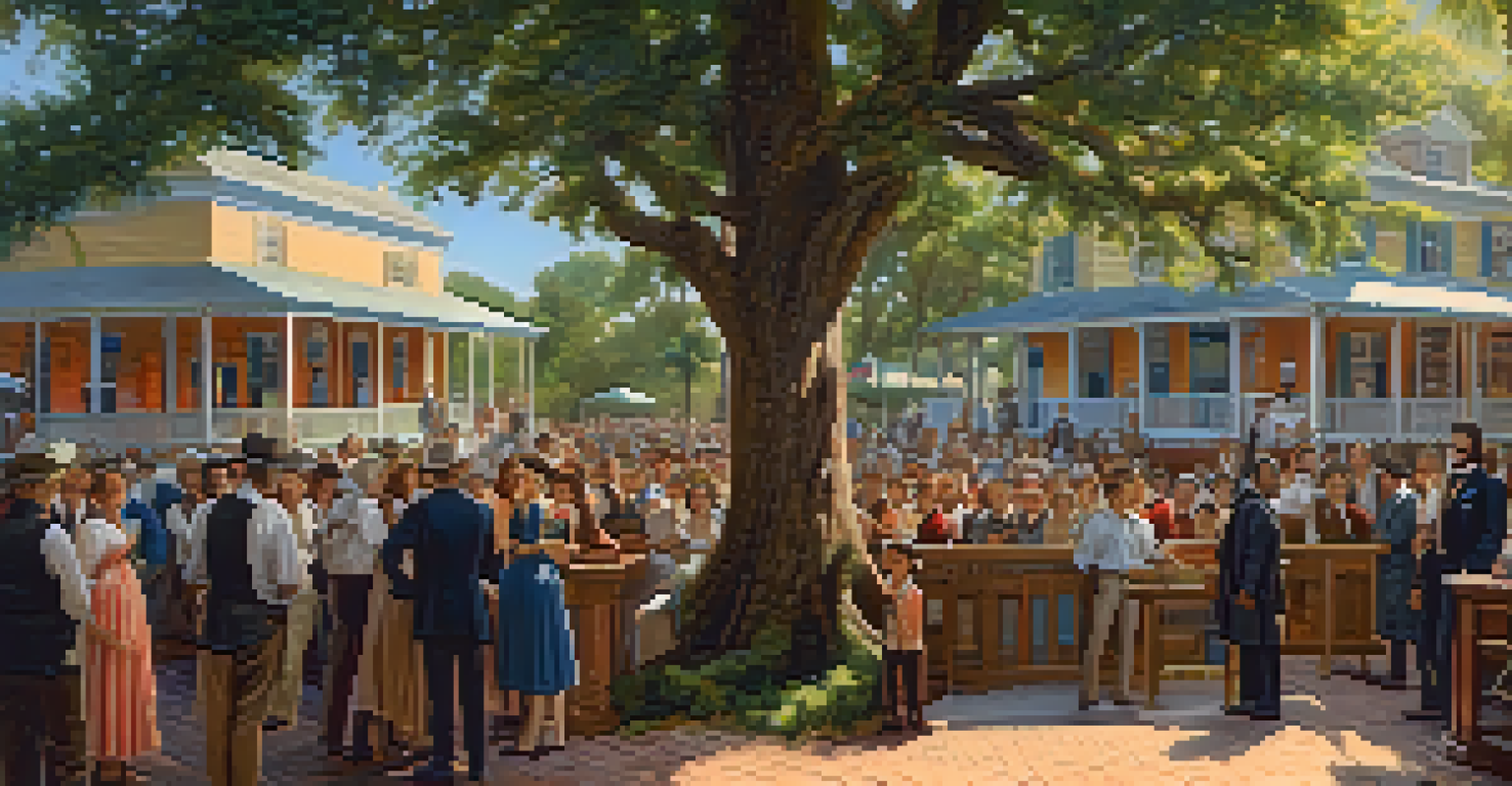The Path to Statehood: Florida's Journey in the 19th Century

Florida's Early Colonial Beginnings in the 19th Century
The story of Florida's path to statehood begins in the early 1800s, a time when it was a Spanish territory. After centuries of colonial rule, Florida was caught in a tug-of-war between the Spanish and the growing American influence in the region. This period saw many settlers from the United States moving in, drawn by the promise of land and opportunity. The arrival of these settlers set the stage for significant changes in Florida's governance and demographics.
Florida is a place of many stories, woven together by the threads of diverse cultures and histories.
In 1821, Florida was ceded to the United States under the Adams-Onís Treaty, marking a pivotal moment in its history. This treaty not only solidified American control but also laid the groundwork for Florida’s eventual statehood. The transition from Spanish to American governance was not without its challenges, as local populations had to adapt to new laws and cultural shifts. This era saw the emergence of new towns and communities as settlers established their roots.
As Florida transitioned into a U.S. territory, the region began to flourish economically, attracting more settlers. Agriculture became a key industry, with crops like cotton and citrus taking center stage. This growth was accompanied by the development of infrastructure, including roads and railways, which connected remote areas to bustling markets. By the mid-19th century, Florida was on a clear trajectory toward becoming a state, fueled by its expanding economy and population.
The Role of Native Americans in Florida's Statehood
The journey to statehood was not solely defined by European settlers; Native American tribes played a crucial role in Florida's history. The Seminole Nation, in particular, resisted American encroachment, leading to a series of conflicts known as the Seminole Wars. These wars were not just battles for territory; they represented a struggle for cultural survival and autonomy against a backdrop of rapid change.

The First Seminole War (1817-1818) was sparked by tensions over land and sovereignty, culminating in U.S. military interventions. This conflict highlighted the complexities of land ownership and the rights of indigenous people in the face of expansionist policies. The U.S. government’s response was often heavy-handed, leading to further resentment and conflict with Native communities. The impact of these wars was profound, shaping the future relationships between the U.S. government and Native Americans.
Florida's Path to Statehood
Florida transitioned from a Spanish territory to a U.S. state in the 19th century, driven by settler migration and economic growth.
Ultimately, the conflicts resulted in the forced removal of many Native Americans from their ancestral lands, significantly altering Florida’s demographic landscape. This displacement not only affected the tribes involved but also transformed the cultural fabric of the region. The legacy of these struggles continues to resonate today, reminding us of the diverse narratives that contribute to Florida's history and identity.
The Influence of the Florida Territory's Governance
As Florida transitioned from a Spanish territory to a U.S. territory, governance became a focal point for residents. The territorial government faced the challenge of integrating diverse populations, including American settlers, Spanish landowners, and Native Americans. Establishing a legal framework that addressed the needs and rights of all residents was no small feat, often leading to political tensions and disputes.
The past is never dead. It's not even past.
In 1838, Florida’s first territorial legislature was established, providing a platform for local governance and representation. This was an important step toward self-governance, allowing Floridians to voice their concerns and aspirations. However, the legislature was primarily composed of white settlers, which meant that the voices of Native Americans and other minority groups were often overlooked. This imbalance in representation would have long-lasting implications for the region.
The governance of Florida during this period also laid the groundwork for future political developments. As the population grew, so did the demand for more autonomy and representation. The push for statehood became increasingly popular, with many Floridians eager to participate fully in the democratic process and secure their rights as citizens. This sentiment played a crucial role in Florida's eventual admission to the Union.
The Growing Demand for Statehood in Florida
By the 1840s, the desire for statehood in Florida was palpable. The influx of settlers, combined with economic growth, fueled aspirations for greater political autonomy. Many residents believed that statehood would provide them with more control over local issues, such as taxation, education, and land rights. This growing sentiment was echoed in public meetings and petitions advocating for statehood.
In 1845, Florida's population had reached the threshold required for statehood, prompting discussions in Congress. Advocates for statehood argued that Florida's unique geography and resources deserved representation on a national stage. However, the journey was not straightforward, as debates over slavery and political representation complicated the path to statehood. Florida's position as a slave state added a layer of complexity to its bid for admission.
Native Americans' Resistance
Native American tribes, particularly the Seminole Nation, played a crucial role in Florida's early history, resisting American encroachment through conflicts that reshaped the region.
Despite these challenges, the momentum for statehood continued to build. In 1845, Florida was officially admitted as the 27th state in the Union. This momentous occasion marked the culmination of years of struggle and aspiration, as Floridians celebrated their newfound status. Yet, it also heralded new challenges, particularly in navigating the contentious issues surrounding slavery and the Civil War.
The Impact of the Civil War on Florida's Statehood
The Civil War, which erupted shortly after Florida achieved statehood, had profound effects on the state and its residents. As a slave state, Florida was embroiled in the conflict, with many residents supporting the Confederacy. The war brought significant upheaval, leading to economic hardship and social strife as communities were torn apart by differing loyalties and ideologies.
Florida's strategic location made it a target for Union forces, resulting in several battles and skirmishes within its borders. The war disrupted trade and agriculture, leading to food shortages and economic instability. Many Floridians found themselves caught in a web of conflicting interests, with families divided over their allegiances. This period of turmoil tested the resilience of Florida’s communities and highlighted the complexities of its identity as a southern state.
The aftermath of the Civil War left Florida grappling with the consequences of its choices. Reconstruction efforts aimed to rebuild the state and address the rights of formerly enslaved individuals, but these initiatives faced significant opposition. The challenges of reintegration and healing would shape Florida's political landscape for years to come, influencing its journey as a state in the years following the war.
The Reconstruction Era and Its Challenges
Following the Civil War, Florida entered the Reconstruction era, a time marked by significant social and political changes. The federal government implemented policies aimed at rebuilding the South and addressing the rights of newly freed African Americans. In Florida, this meant establishing new educational systems and local governments that included formerly enslaved individuals.
However, the realities of Reconstruction were far from ideal. Many white Floridians resisted the changes, leading to tensions and violence across the state. Organizations like the Ku Klux Klan emerged, seeking to undermine the progress made by African Americans and restore white supremacy. This backlash created an environment of fear and uncertainty, complicating efforts to achieve true equality.
Challenges of Reconstruction
The Reconstruction era brought significant social changes in Florida, with efforts to integrate formerly enslaved individuals facing resistance and violence.
Despite these challenges, the Reconstruction era also saw the emergence of Black leaders and communities actively advocating for their rights. The establishment of schools and churches provided spaces for empowerment and solidarity among African Americans. This period laid the groundwork for future civil rights movements, as the struggle for equality continued long after the official end of Reconstruction.
Florida's Path to Modern Statehood and Identity
As the 19th century drew to a close, Florida was evolving into a unique state with a rich tapestry of cultures and histories. The legacies of early settlers, Native Americans, and African Americans intertwined to shape Florida's identity. This diversity became a defining characteristic of the state, influencing its social dynamics and cultural expressions.
The state continued to face challenges, including economic fluctuations and natural disasters, which tested the resilience of its communities. Events such as the Great Freeze of 1894-1895 devastated the citrus industry, prompting many to seek new opportunities elsewhere. Nonetheless, these hardships also spurred innovation and adaptation, as Floridians learned to navigate the changing landscape.

By the turn of the century, Florida had firmly established itself as a vital part of the United States, contributing to the broader national narrative. The journey from a Spanish territory to a state was marked by struggle, resilience, and transformation. As Florida moved into the 20th century, its diverse history and experiences would continue to shape its identity, setting the stage for the vibrant state we know today.